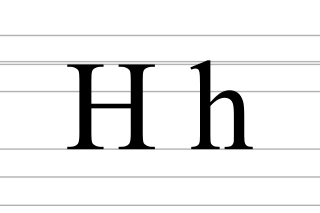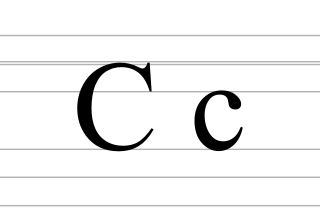
A diacritic is a glyph added to a letter or to a basic glyph. The term derives from the Ancient Greek διακριτικός, from διακρίνω. The word diacritic is a noun, though it is sometimes used in an attributive sense, whereas diacritical is only an adjective. Some diacritics, such as the acute ⟨ó⟩, grave ⟨ò⟩, and circumflex ⟨ô⟩, are often called accents. Diacritics may appear above or below a letter or in some other position such as within the letter or between two letters.

H, or h, is the eighth letter of the Latin alphabet, used in the modern English alphabet, including the alphabets of other western European languages and others worldwide. Its name in English is aitch, or regionally haitch.

S, or for lowercase, s, is the nineteenth letter of the Latin alphabet, used in the English alphabet, the alphabets of other western European languages and other latin alphabets worldwide. Its name in English is ess, plural esses.
A cedilla, or cedille, is a hook or tail added under certain letters to indicate that their pronunciation is modified. In Catalan, French, and Portuguese it is used only under the letter ⟨c⟩, and the entire letter is called, respectively, c trencada, c cédille, and c cedilhado. It is used to mark vowel nasalization in many languages of Sub-Saharan Africa, including Vute from Cameroon.

Fraktur is a calligraphic hand of the Latin alphabet and any of several blackletter typefaces derived from this hand. It is designed such that the beginnings and ends of the individual strokes that make up each letter will be clearly visible, and often emphasized; in this way it is often contrasted with the curves of the Antiqua (common) typefaces where the letters are designed to flow and strokes connect together in a continuous fashion. The word "Fraktur" derives from Latin frāctūra, built from frāctus, passive participle of frangere, which is also the root for the English word "fracture". In non-professional contexts, the term "Fraktur" is sometimes misused to refer to all blackletter typefaces – while Fraktur typefaces do fall under that category, not all blackletter typefaces exhibit the Fraktur characteristics described above.
A caronKARR-ən. or háček, is a diacritic mark placed over certain letters in the orthography of some languages, to indicate a change of the related letter's pronunciation. Typographers tend to use the term caron, while linguists prefer the Czech word háček.

The letter F with hook is a letter of the Latin script, based on the italic form of f; or on its regular form with a descender hook added. A very similar-looking letter, ⟨ʄ⟩, is used in the IPA for a voiced palatal implosive.

The grapheme Š, š is used in various contexts representing the sh sound like in the word show, usually denoting the voiceless postalveolar fricative /ʃ/ or similar voiceless retroflex fricative /ʂ/. In the International Phonetic Alphabet this sound is denoted with ʃ or ʂ, but the lowercase š is used in the Americanist phonetic notation, as well as in the Uralic Phonetic Alphabet. It represents the same sound as the Turkic letter Ş and the Romanian letter Ș (S-comma), the Hebrew and Yiddish letter ש, the Ge'ez (Ethiopic) letter ሠ,the Cyrillic letter Ш, the Arabic letter ش, and the Armenian letter Շ(շ).

Ŝ or ŝ is a consonant in Esperanto orthography, representing the sound.

A digraph or digram is a pair of characters used in the orthography of a language to write either a single phoneme, or a sequence of phonemes that does not correspond to the normal values of the two characters combined.

EzhEZH, also called the "tailed z", is a letter, notable for its use in the International Phonetic Alphabet (IPA) to represent the voiced postalveolar fricative consonant. This sound, sometimes transcribed /zh/, occurs in the pronunciation of ⟨si⟩ in vision and precision, the ⟨s⟩ in treasure, and the ⟨g⟩ in beige.

Esh is a character used in phonology to represent the voiceless postalveolar fricative.
Diacritical marks of two dots¨, placed side-by-side over or under a letter, are used in several languages for several different purposes. The most familiar to English-language speakers are the diaeresis and the umlaut, though there are numerous others. For example, in Albanian, ë represents a schwa. Such diacritics are also sometimes used for stylistic reasons.

L, or l, is the twelfth letter of the Latin alphabet, used in the modern English alphabet, the alphabets of other western European languages and others worldwide. Its name in English is el, plural els.

J, or j, is the tenth letter of the Latin alphabet, used in the modern English alphabet, the alphabets of other western European languages and others worldwide. Its usual name in English is jay, with a now-uncommon variant jy.

C, or c, is the third letter of the Latin alphabet, used in the modern English alphabet, the alphabets of other western European languages and others worldwide. Its name in English is cee, plural cees.
In typesetting, the hook or tail is a diacritic mark attached to letters in many alphabets. In shape it looks like a hook and it can be attached below as a descender, on top as an ascender and sometimes to the side. The orientation of the hook can change its meaning: when it is below and curls to the left it can be interpreted as a palatal hook, and when it curls to the right is called hook tail or tail and can be interpreted as a retroflex hook. It should not be mistaken with the hook above, a diacritical mark used in Vietnamese, or the rhotic hook, used in the International Phonetic Alphabet.

With the adoption of letters from the International Phonetic Alphabet (IPA) in various national alphabets, letter case forms have been developed. This usually means capital (uppercase) forms were developed, but in the case of the glottal stop, both uppercase ⟨Ɂ⟩ and lowercase ⟨ɂ⟩ are used.

Ꞥ is a letter derived from the combination of the Latin letter N and a stroke diacritic. Until 1921, it was used in Latvian orthography to represent the hard palatal nasal /ɲ/. It was replaced by Ņ.

Ꞧ is a letter derived from the Latin alphabet letter R, combined with bar diacritic.




















